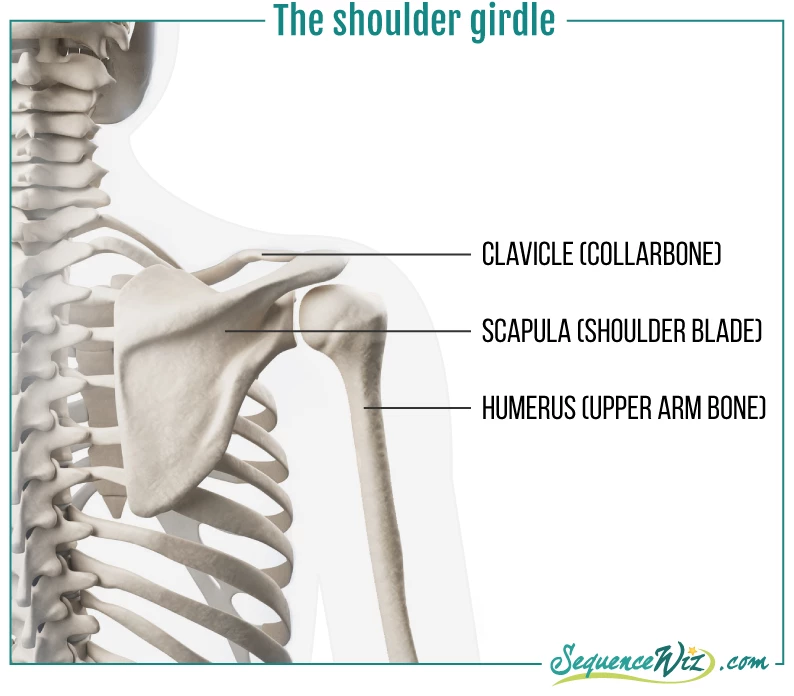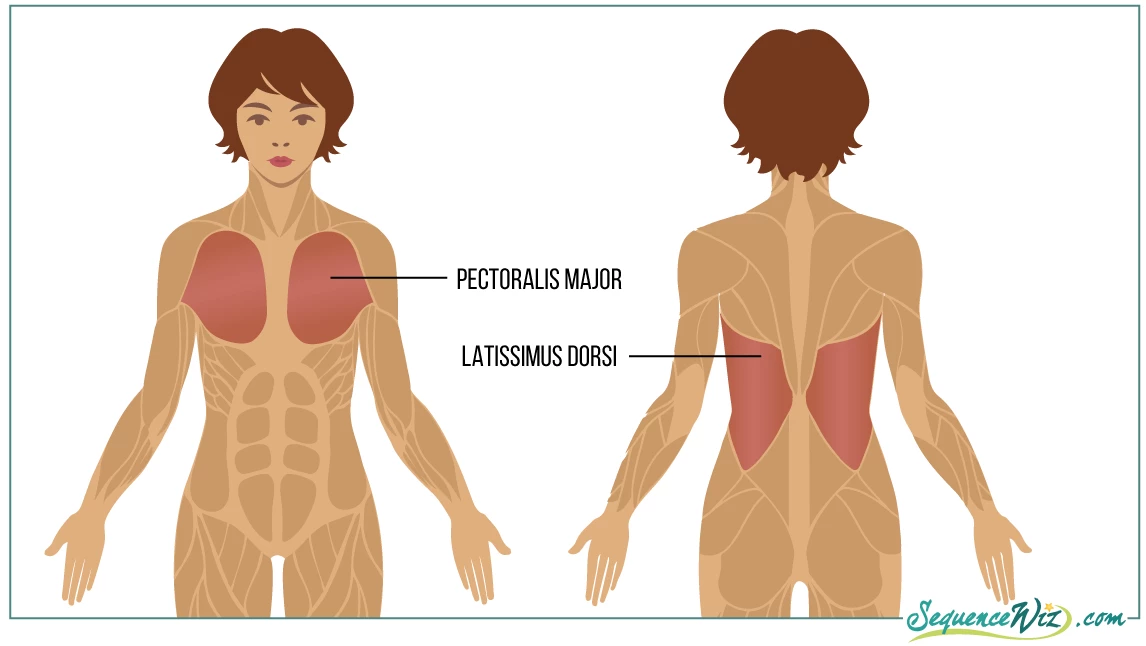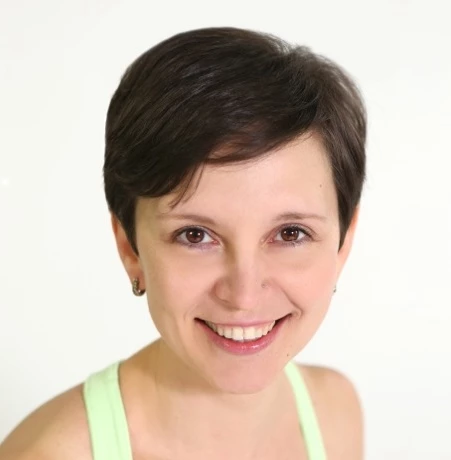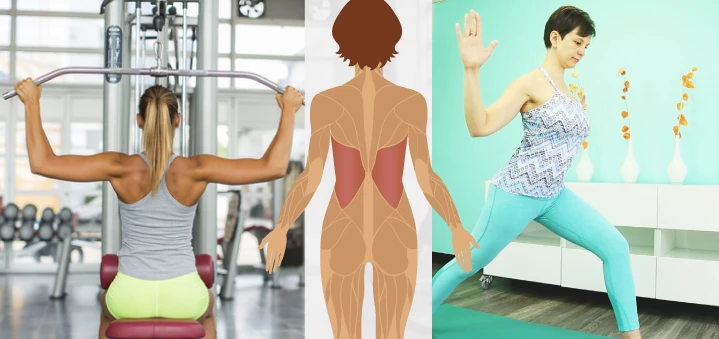3 Essential Steps to Protecting Your Shoulders in Yoga

I started taking tennis lessons recently. My tennis pro tells us in every class: “Save your shoulders! Do not swing with just your arm, turn your whole body!” All athletes know that – we cannot generate any kind of significant force if we just flail our arms. More then that – if we rely on our arms alone (especially if we are carrying weight, like a golf club or a tennis racket), we are risking shoulder strain, pain and potentially dislocation.
This is just as relevant in our daily lives. Whether you drag your heavy suitcase at the airport, pull to open a heavy door or lift your kid, you are risking shoulder strain if you are not mindful about where the movement is coming from. Here are some basic ideas on how to protect your shoulders in your daily life and in your yoga practice.
Step 1. Pay Attention to Shoulder Blade Mobility in Yoga
The first thing to remember is that the arm does not function in isolation. The whole structure is called “the shoulder girdle” and it includes the arm, the clavicle (collar bone) and scapula (shoulder blade). All these structures are meant to work together.  What we often see in the yoga classes (as well as daily lives), is limited movement of the shoulder blades. When the shoulder blade doesn’t move much, it is not supporting the shoulder joint. So whatever arm movement you do, try to pay attention to what your shoulder blade is doing and emphasize that movement. This is where we want the arm movement to ORIGINATE FROM, with the arm just following the movement of the shoulder blade. Whenever I work with a yoga student with shoulder issues, the first thing I check is how much awareness/mobility she has in her shoulder blades.
What we often see in the yoga classes (as well as daily lives), is limited movement of the shoulder blades. When the shoulder blade doesn’t move much, it is not supporting the shoulder joint. So whatever arm movement you do, try to pay attention to what your shoulder blade is doing and emphasize that movement. This is where we want the arm movement to ORIGINATE FROM, with the arm just following the movement of the shoulder blade. Whenever I work with a yoga student with shoulder issues, the first thing I check is how much awareness/mobility she has in her shoulder blades.
Step 2. Counteract Internal Rotation of the Shoulders in Asanas
The second thing to remember is that both pectoralis major (chest muscles) and latissimus dorsi (back muscles) attach at the anterior (front surface) of the arm bone. Reflect on that for a moment.
It means that when your chest muscles are tight, they will try to rotate your arm internally. It also means that when your lats on the back are tight they will ALSO try to rotate your arm internally. As we’ve already established, excessive internal shoulder rotation can lead to all sorts of problems on and off the yoga mat. That is why when you deal with shoulder issues it is not enough to just stretch the chest (as we often see), but also to release tension in your lats. How do we do that? The easiest way is to add a lat pull down-like movement to your poses.
We can add those to Virabhadrasana (Warrior Pose), Salabhasana (Locust Pose), Ardha Uttansana (Forward Bend), etc.
The trick here is to make sure that the student engages the proper muscles.
Ways to Ensure Your Yoga Student is Engaging the Correct Muscles
-
Ask your students to pull down using the muscles underneath the shoulder blades.
-
Place your hands (or fingertips) on the student’s lats and ask to originate the movement there.
-
Have your student hold on to your fingers and resist as they pull down, checking to make sure that the movement is coming from the lats.
Step 3. Move from the Spine During Yoga Practice
The third important thing is that whatever movement we do in yoga needs to involve the spine. When you move the spine, you end up working with all the structures that bind the shoulder girdle to the spine, making each movement more effective. When we pull the arms down or back, we also flatten the thoracic curve; when we stretch the arms forward, we also round the thoracic curve, when we bring the arm across we also twist the spine, and so on.
That is why in my tradition you will rarely see a teacher do any sort of isolated shoulder stretches in a seated or any other static position (except for demonstration purposes). This is because the movement of the shoulder needs to be organically linked to the rest of the body, specifically the movement of the spine, so that the complex network of muscles that connects the shoulder girdle to the spine and ribcage gets alternately stretched and strengthened.
Until the student thoroughly understands the three main principles above, he/she has no business doing Sun Salutation-heavy yoga practices and other weight-bearing maneuvers that place a lot of stress on the shoulders; it’s just too risky.
Printed with permission from sequencewiz.com
Read more on shoulder safety in yoga class from YogaUOnline and Natasha Rizopoulos.
 Educated as a school teacher, Olga Kabel has been teaching yoga for over 14 years. She completed multiple Yoga Teacher Training Programs, but discovered the strongest connection to the Krishnamacharya/ T.K.V. Desikachar lineage. She had studied with Gary Kraftsow and American Viniyoga Institute (2004-2006) and received her Viniyoga Teacher diploma in July 2006 becoming an AVI-certified Yoga Therapist in April 2011. Olga is a founder and managing director of Sequence Wiz- a web-based yoga sequence builder that assists yoga teachers and yoga therapists in creating and organizing yoga practices. It also features simple, informational articles on how to sequence yoga practices for maximum effectiveness. Olga strongly believes in the healing power of this ancient discipline on every level: physical, psychological, and spiritual. She strives to make yoga practices accessible to students of any age, physical ability and medical history specializing in helping her students relieve muscle aches and pains, manage stress and anxiety, and develop mental focus.
Educated as a school teacher, Olga Kabel has been teaching yoga for over 14 years. She completed multiple Yoga Teacher Training Programs, but discovered the strongest connection to the Krishnamacharya/ T.K.V. Desikachar lineage. She had studied with Gary Kraftsow and American Viniyoga Institute (2004-2006) and received her Viniyoga Teacher diploma in July 2006 becoming an AVI-certified Yoga Therapist in April 2011. Olga is a founder and managing director of Sequence Wiz- a web-based yoga sequence builder that assists yoga teachers and yoga therapists in creating and organizing yoga practices. It also features simple, informational articles on how to sequence yoga practices for maximum effectiveness. Olga strongly believes in the healing power of this ancient discipline on every level: physical, psychological, and spiritual. She strives to make yoga practices accessible to students of any age, physical ability and medical history specializing in helping her students relieve muscle aches and pains, manage stress and anxiety, and develop mental focus.




